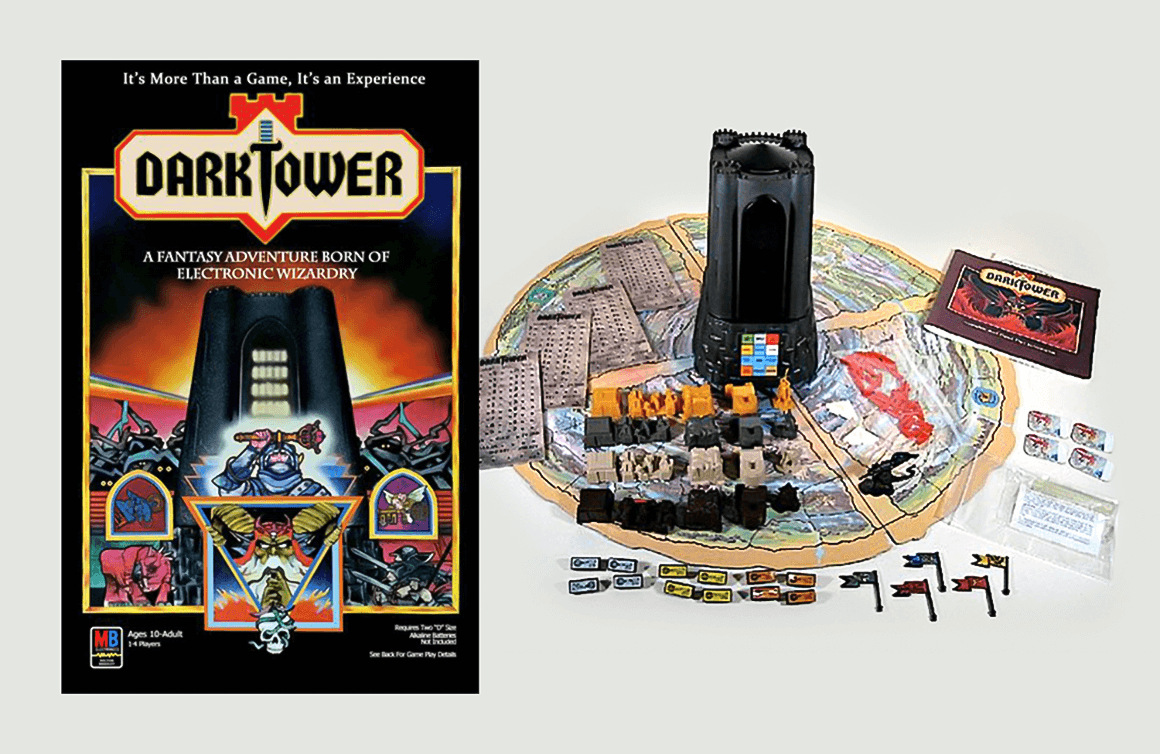Dark Tower was one of my favorite boardgames as a kid. It was an “electronic boardgame,” a category that came to life in the late 1970s and early 1980s with Electronic Battleship (1977), the D&D Computer Labyrinth Game (1980), and then Dark Tower (1981). (No relation to the Stephen King series of books that began in 1982.)
Dark Tower really was a boardgame, complete with a board and player pawns (nicely sculpted plastic warriors, as well as a dragon miniature) with a rotating computer assistant shaped like a black tower.

Words won’t do it justice. Check out this video.
The game design and electronics design are both really elegant, as is the game play. You need to travel to each of the other three kingdoms to find the keys to the Dark Tower itself (a brass key, then a silver key, then a gold key, one per kingdom, always in that order). Along the way you will get lost, lose warriors to plague and starvation, and suffer attacks by brigands and the dragon. You can search tombs and ruins, shop at a bazaar, perhaps seek help at a sanctuary. Once you have the three keys, return to your home kingdom, muster additional warriors, and assault the Dark Tower. First, you’ll unlock the riddle of the keys (their correct order), then attack. This is a race game—the first player to conquer the Dark Tower wins.
There’s also a solo mode, where you try to achieve the highest score, based on how quickly you assault the Dark Tower and with how few warriors you successfully assaulted the tower with (the fewer the warriors, the higher the score).
Original rules (PDF). You can play the game on an iPad or on Steam with Tabletop Simulator. That said, there’s nothing quite like playing with the actual board and pieces, should you be so lucky.
Nostalgia Play
After my copy of Dark Tower stopped working, I gave it to a friend who loves retrocomputing projects, Kyle of Kyle’s Lab. He quickly got it running again. Not only that, he refurbished the game, getting two new minis to replace missing ones, 3D-printing some new game pegs and keys, and inkjet-printing some labels for the keys and the Pegasus. I’d given him a well-loved, well-worn game (the box itself is long gone).
The gameplay is not strategic, but there are some tactical decisions to make: where to go next and what to buy at the bazaar. The race aspect encourages you to push your luck sometimes. The amount of food needed increases with the size of the army and makes it harder to just maintain a huge army. You need to tediously track your food manually on a pegboard, otherwise your warriors may starve (though the tower will ominously warn you a few turns before).
Is it a great game by modern standards? No, as it’s basically move and “roll” (the computer does the roll for you).
Both the other players were new to the game and found it to be an enjoyable experience, if not one they are eager to repeat. As SultanSevy put it on BoardGameGeek, “Without the tower, this game wouldn’t be on anyone’s radar; the gameplay is rather boring. But there’s something geeky-cool about that whirring, beeping black overlord that ultimately salvages the game and makes it fun to break out on occasion.”



You must be logged in to post a comment.